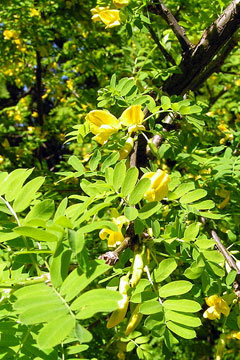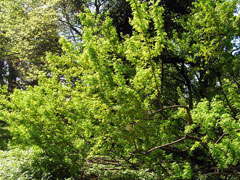 |
|
http://commons.wikimedia.org/wiki/User:Athenchen |
 |
| http://commons.wikimedia.org/wiki/User:Athenchen |
Translate this page:
Summary
Physical Characteristics

 Caragana boisii is a deciduous Shrub growing to 2 m (6ft) by 1.5 m (5ft) at a fast rate.
Caragana boisii is a deciduous Shrub growing to 2 m (6ft) by 1.5 m (5ft) at a fast rate.
See above for USDA hardiness. It is hardy to UK zone 2. It is in flower in May, and the seeds ripen in September. The species is hermaphrodite (has both male and female organs) and is pollinated by Bees.
It can fix Nitrogen.
It is noted for attracting wildlife.
Suitable for: light (sandy) and medium (loamy) soils, prefers well-drained soil and can grow in nutritionally poor soil. Suitable pH: mildly acid, neutral and basic (mildly alkaline) soils and can grow in very alkaline soils.
It cannot grow in the shade. It prefers dry or moist soil and can tolerate drought. The plant can tolerates strong winds but not maritime exposure.
UK Hardiness Map
US Hardiness Map
Synonyms
C. microphylla crasse-aculeata. C. arborescens crasse-aculeata.
Plant Habitats
Woodland Garden Sunny Edge; Hedge;
Edible Uses
Edible Parts: Oil Seed Seedpod
Edible Uses: Oil
The following uses are for the closely related C. arborescens and can probably also be applied to this species[K]. Seed - cooked[2, 105]. Small but produced in abundance[11], there are 4 - 6 seeds per pod[202]. A bland flavour, it is best used in spicy dishes[183]. The raw seed has a mild pea-like flavour, though we are not sure if it should be eaten in quantity when raw[K]. The seed contains 12.4% of a fatty oil and up to 36% protein[183], it has been recommended as an emergency food for humans[65]. Young pods - cooked and used as a vegetable[46, 61, 105, 177, 183].
References More on Edible Uses
Medicinal Uses
Plants For A Future can not take any responsibility for any adverse effects from the use of plants. Always seek advice from a professional before using a plant medicinally.
None known
References More on Medicinal Uses
The Bookshop: Edible Plant Books
Our Latest books on Perennial Plants For Food Forests and Permaculture Gardens in paperback or digital formats.

Edible Tropical Plants
Food Forest Plants for Hotter Conditions: 250+ Plants For Tropical Food Forests & Permaculture Gardens.
More

Edible Temperate Plants
Plants for Your Food Forest: 500 Plants for Temperate Food Forests & Permaculture Gardens.
More

More Books
PFAF have eight books available in paperback and digital formats. Browse the shop for more information.
Shop Now
Other Uses
Dye Fibre Hedge Hedge Oil Shelterbelt Soil stabilization
The following uses are for the closely related C. arborescens and can probably also be applied to this species[K]. A fibre is obtained from the bark, used for cordage[46, 61, 74]. A blue dye is obtained from the leaves[74]. The seed contains 12.4% of a fatty oil[74]. The plant can be grown as a hedge[160]. It is quite wind-resistant and can also be planted in a shelterbelt[200]. The plant has an extensive root system and can be used for erosion control, especially on marginal land[160].
Special Uses
Attracts Wildlife Hedge Hedge Nitrogen Fixer
References More on Other Uses
Cultivation details
Succeeds in most well-drained soils, preferring full sun and a light sandy dry or well-drained soil[1, 11, 200]. Tolerates very alkaline soils[202]. Does not require a rich soil[1, 11, 108], succeeding on marginal land[160]. Established plants are drought resistant[160]. Fast growing[188]. This species is hardy to at least -30°c[184], it prefers a continental climate with hot summers and cold winters so it does not grow so well in the milder western half of Britain[200]. This species is closely related to C. arborescens, differing in the longer teeth of the calyx and in the downy ovary and young fruit[11]. It can probably be used in all the ways C. arborescens is used and therefore has an excellent potential for human food.[K]. A good bee plant[74]. Plants in this genus are notably resistant to honey fungus[200]. This species has a symbiotic relationship with certain soil bacteria, these bacteria form nodules on the roots and fix atmospheric nitrogen. Some of this nitrogen is utilized by the growing plant but some can also be used by other plants growing nearby[200].
References Carbon Farming Information and Carbon Sequestration Information
Temperature Converter
Type a value in the Celsius field to convert the value to Fahrenheit:
Fahrenheit:
The PFAF Bookshop
Plants For A Future have a number of books available in paperback and digital form. Book titles include Edible Plants, Edible Perennials, Edible Trees,Edible Shrubs, Woodland Gardening, and Temperate Food Forest Plants. Our new book is Food Forest Plants For Hotter Conditions (Tropical and Sub-Tropical).
Shop Now
Plant Propagation
Seed - best sown as soon as it is ripe in a cold frame[200]. It usually germinates in 2 weeks[K]. Stored seed should be pre-soaked for 24 hours in warm water then sown in a cold frame[78, 113, 200]. If the seed has not swollen then scarify it and re-soak for another 12 hours before sowing[138]. Germination usually takes place within 2 - 3 weeks at 20°c[138]. Good percentage[11]. As soon as they are large enough to handle, prick the seedlings out into individual pots and grow them on in a greenhouse for at least their first winter. Plant them out into their permanent positions in late spring or early summer, after the last expected frosts. Cuttings of half-ripe wood, 7 - 10cm with a heel, July/August in a frame[113]. Layering in spring.
Other Names
If available other names are mentioned here
Native Range
TEMPERATE ASIA: Shaanxi Sheng (south), Sichuan Sheng,China.
Weed Potential
Right plant wrong place. We are currently updating this section.
Please note that a plant may be invasive in one area but may not in your area so it's worth checking.
Conservation Status
IUCN Red List of Threatened Plants Status :

Growth: S = slow M = medium F = fast. Soil: L = light (sandy) M = medium H = heavy (clay). pH: A = acid N = neutral B = basic (alkaline). Shade: F = full shade S = semi-shade N = no shade. Moisture: D = dry M = Moist We = wet Wa = water.
Now available:
Food Forest Plants for Mediterranean Conditions
350+ Perennial Plants For Mediterranean and Drier Food Forests and Permaculture Gardens.
[Paperback and eBook]
This is the third in Plants For A Future's series of plant guides for food forests tailored to
specific climate zones. Following volumes on temperate and tropical ecosystems, this book focuses
on species suited to Mediterranean conditions—regions with hot, dry summers and cool, wet winters,
often facing the added challenge of climate change.
Read More
Expert comment
Author
Schneid
Botanical References
11
Links / References
For a list of references used on this page please go here
Readers comment
| Add a comment |
|
If you have important information about this plant that may help other users please add a comment or link below. Only comments or links that are felt to be directly relevant to a plant will be included. If you think a comment/link or information contained on this page is inaccurate or misleading we would welcome your feedback at [email protected]. If you have questions about a plant please use the Forum on this website as we do not have the resources to answer questions ourselves.
* Please note: the comments by website users are not necessarily those held by PFAF and may give misleading or inaccurate information.
To leave a comment please Register or login here All comments need to be approved so will not appear immediately.
|
Subject : Caragana boisii
|
|
|
|